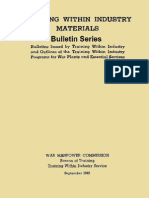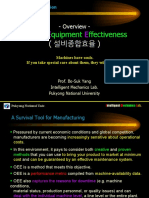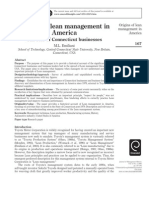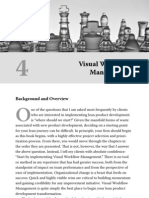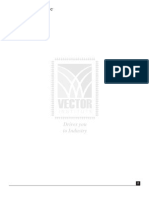Lean Mro Productivity
Lean Mro Productivity
Uploaded by
Deepak BindalCopyright:
Available Formats
Lean Mro Productivity
Lean Mro Productivity
Uploaded by
Deepak BindalOriginal Description:
Copyright
Available Formats
Share this document
Did you find this document useful?
Is this content inappropriate?
Copyright:
Available Formats
Lean Mro Productivity
Lean Mro Productivity
Uploaded by
Deepak BindalCopyright:
Available Formats
Lean opportunities in MRO Procurement: Improved productivity and reduced waste
In an increasingly competitive global environment, organizations must innovate to find opportunities to improve their productivity and reduce total cost. Initiatives that consider ALL aspects of process improvement and waste reduction will find the greatest level of success in improving efficiency.
What is productivity?
Productivity is output, efficiency, and production. In economic terms, it is the rate at which a company produces goods or services in relation to a needed amount of materials and employees. Productivity can be defined in two ways: 1) Total labor productivity is simply output divided by the number of workers, or by the number of hours worked. Output can be anything from number of packages to airline miles flown, but more generally it is some very broad aggregate like gross domestic product. Measures of labor productivity capture the contribution to output of other inputs than hours worked. 2) Total factor productivity, by contrast, captures the contribution to output of everything except labor and capital. Innovation, managerial skill, organization, waste minimization (all forms) and even luck can contribute. 1 The two productivity concepts are related. Increases in total labor productivity, the amount of output created (in terms of goods produced or services rendered) per unit input used, can reflect the fact that each worker is better equipped with capital. Alternatively, gains in total factor productivity, or any effects in total output not caused by inputs or productivity, are frequently obtained through the use of innovative process improvements or organizational change.
What is waste?
Waste can be identified many ways and as many things, but ultimately it is any activity that requires allocated resources but adds no value from the customers perspective. Some activities, while not directly adding value to a product or process such as time spent on equipment maintenance or the accounting function are necessary in the production of goods or services and must be perpetuated. Other types of non-value-added activities, like maintaining underutilized inventories or the time wasted searching for tools, must be reviewed and constantly re-evaluated, and if identified as waste, the appropriate steps must be taken to eliminate them. Many initiatives and systematic approaches for improving efficiency have been adopted by manufacturing organizations to help improve their products and processes by focusing on quality, improving productivity and reducing all types of waste.
Productivity improvement methodologies
The Toyota Production System, developed in Japan in the 1940s, is the framework and philosophy organizing the manufacturing facilities at Toyota and the interaction of these facilities with their suppliers and customers. The philosophy was largely developed and popularized by Toyota engineer Taiichi Ohno. The main goal of TPS (commonly referred to these days as lean methodologies) is to eliminate all forms of waste within manufacturing operations, but has become a very popular tool for improving efficiencies in ALL types of organizations. Another improvement method called Total Quality Management (TQM) is a management approach for an organization. TQM is centered on quality, based on the participation of all organizational members and aimed at long-term success through customer satisfaction and system-wide benefits. Popular in the U.S. during the 1980s, it was developed by W. Edwards Deming and is largely based on the quality revolution started in Japan in the 1940s. Six Sigma was pioneered by Bill Smith at Motorola, and popularized in manufacturing environments by General Electrics former CEO, Jack Welch. It emphasizes the use of mathematical and statistical tools to manage process variations that can cause defects, and systematically works toward managing the ultimate goal of consistent and measurable quality. These approaches to improve productivity and minimize waste are being used by many organizations to improve their products and processes. Based on the results of the 2006 IndustryWeek/MPI Census of Manufacturers, the implementation of lean methodologies have significantly increased in popularity. In 2006, 40.5 percent of all manufacturers surveyed have adopted lean as their primary improvement method, a jump of nearly 5 percent from the 35.7 percent reported in 2005. 2
Lean Initiatives for reducing waste
Lean methodologies based on the Toyota Production System are management philosophies that focus on the reduction of the seven deadly wastes: Overproduction Waiting time Transportation Processing Inventory Motion Scrap in manufactured products or any type of business By eliminating waste (roughly translated in Japanese as muda), quality is improved, production time is reduced and cost is reduced. Lean tools (more than three dozen, and growing) include constant process analysis and continuous improvement (kaizen), pull production (by means of kanban) and mistake-proofing (poka-yoke). Lean, as a management philosophy, is also very focused on creating a better workplace through the Toyota principle of respect for humanity.
While some believe that lean methodologies are a set of problem-solving tools, most experts now agree that it is a holistic, comprehensive, enterprise-wide program designed to be integrated into the organizations core strategy. Key lean principles also include: Continuous improvement: Efforts to reduce costs, improve quality, increase productivity and share information. Flexibility: Efforts to produce different mixes or greater diversity of products quickly, without sacrificing efficiency at lower volumes of production. Supply chain enhancement: Building and maintaining a long-term, strategic relationship with suppliers through collaborative risk-sharing, cost-sharing and information-sharing arrangements. Lean basically gets the right things to the right place at the right time in the right quantity while minimizing waste and being flexible and open to change. 3
Lean implications for MRO/indirect materials procurement and inventory
Indirect procurement activities concern operating resources that a company purchases to enable its operations. It comprises a wide variety of goods and services, from standardized low-value items like office supplies and products used in facilities maintenance, repair and operations (MRO), to complex and costly goods and services like heavy equipment and consulting services. Purchasing organizations in many industries sometimes assume incorrectly that just-incase stores of indirect goods, specifically those used in the maintenance and repair of plants and facilities, are less costly than the cost of downtime or lost production. The perceived pain of not having what may or may not be needed in an emergency or downtime situation often creates inventories of things that are never used or become obsolete or damaged. In lean terms, these underutilized or obsolete inventories, and the associated procurement activities (those not directly related to production), are considered waste, or muda. The time and resources involved with information administration and gathering, supplier contacts, background reviews, negotiations, and fulfillment activities of indirect materials create waste and reduce overall production activity in often intangible but very real terms. Many organizations have strategic sourcing initiatives in place, but they do not extend to the indirect purchasing categories, specifically MRO. Literally hundreds of thousands of products can be considered MRO in categories such as lighting or safety products. Of this category of products, buyers consider about 40 percent of requirements are for spot buys or unplanned purchases.
What is an unplanned purchase?
Unplanned purchases refer to the type of buying occasion associated with maintenance, repair and operations (MRO) products that are bought infrequently and needed on an unpredictable basis and not typically purchased year after year. The purchase is unplanned not because someone isnt a good buyer or maintenance professional. While frequently considered emergency downtime situations, these occasions are unplanned truly because of the way the item behaves in a facility. An example would be an elevators up and down button. Neither purchasing nor maintenance plans for the button to go out; and when it does, purchasing typically needs to place an order for the item if it is not found on a storeroom shelf. 4
Supplier consolidation lowers costs and improves productivity
The trend in the facilities maintenance business is moving toward organizations trying to reduce the number of suppliers and lower the cost of procuring tools, safety equipment, lighting and other maintenance products used to keep their businesses running. What is actually required in these situations are lean supply channels that: 1) possess more of a thorough understanding of customer needs; and, 2) are able to provide needed goods at the appropriate place and time as determined by demand (pulled). This methodology would solve two problems the reduction of the costs (waste) associated with holding rarely used items in inventories, and allowing organizations to focus on their core competencies and production efforts, not spending time (waste) sourcing and procuring infrequently used MRO requirements.
For planned purchases, a typical company will use 5 to 10 suppliers from whom they purchase a few high-volume commodity items. For unplanned purchases, a typical company will have more than 20 suppliers to buy thousands of different products every year. Managing those relationships and adjusting to different suppliers take time and affect productivity. Managing as few relationships as possible for making unplanned purchases will minimize procurement complexity and its associated costs. In some cases, MRO suppliers even offer discount structures tied specifically to the indirect spend for buyers who use a consolidated approach for MRO purchases.
Consolidation to one source simplifies the process, saves valuable time, and reduces costs for product search and availability, resulting in increased productivity.
Consider a broad-line national MRO distributor.
Many broad-line national distributors maintain inventories of literally hundreds of thousands of MRO items. They use extensive networks of distribution centers and local branch offices to ensure prompt and reliable deliveries to their customers. To ensure their success, they have developed strong relationships with thousands of manufacturers of the items needed to maintain, repair, and operate all types of facilities. This integrated approach ultimately saves customers time and money. The scale advantages provided by broad product lines, extensive customer coverage and logistics network of branches/distribution centers position them as the perfect solution for unplanned occasion purchases. In addition, a few have electronic business (e-business) technology expertise that can provide customers with procurement integration solutions to handle and streamline the indirect product purchasing processes. Look for a distributor that offers a range of e-solutions that will grow with your future needs, whether youre integrating a sophisticated e-procurement system or streamlining your ordering process from electronic data interchange (EDI) and marketplace platforms, to online order management tools. These types of systems will provide some real, easy-to-take cost benefits, like less inventory, better cash flow and lower labor costs. If available, utilize the consulting services teams that are available at some of these distributors. They have significant experience with MRO procurement practices, and will be happy to share their insights with you. They use that knowledge to create a powerful set of diagnostic, analytical and reporting tools that can give customers a major advantage in identifying cost inefficiencies and correcting them. They are applied by experienced people who work closely with customers to ensure smooth transitions, and complete integration for maximum results. Choose a broad-line national distributor who is positioned to consistently supply the right product, to the right place, at the right time. Identify one whose integrated solutions will help improve efficiency, maximize productivity and reduce total cost - by helping to minimize your inventory investments, the time and effort required procuring them. As with any LEAN initiative, focusing on reducing waste in your MRO procurement practices will be beneficial and tangible for your organization.
Log on to www.grainger.com, or call or visit your local Grainger branch office, for more information about how a consolidated approach to MRO purchases can benefit your organization. Sources of Information 1. Sylvia Nasar The Concise Encyclopedia of Economics 1993, 2002 David R. Henderson - http://www.econlib.org/library/Enc/Productivity.html 2. IndustryWeek/Manufacturing Performance Institute Census of Manufacturers October 1, 2006 - http://www.industryweek.com 3. James Womack & Daniel Jones, Lean Thinking 1996 Simon & Schuster Principles of LEAN 1997-2006 by the Lean Enterprise Institute http://www.lean.org/WhatsLean/Principles.cfm 4. The Power of Planning the Unplanned - Solutions from Grainger W.W. Grainger 2006 The Center for Industrial Research and Service (CIRAS) 2005, Iowa State University of Science and Technology. http://www.ciras.iastate.edu/library/toc/distributionsupplychain.asp Wikipedia September 2006 2000, 2001, 2002 Free Software Foundation, Inc. http://en.wikipedia.org Optimizing MRO Inventory Management Bryan Ashenbaum CAPS Research -Critical Issues Report, August 2005 http://www.capsresearch.org/publications/pdfs-protected/cir082005.pdf
You might also like
- OpenCart TestCasesDocument423 pagesOpenCart TestCasesAMIT TIWARI100% (7)
- Drystar 5302 Service ManualDocument461 pagesDrystar 5302 Service ManualJosé Martínez94% (17)
- How To Build A NeobankDocument20 pagesHow To Build A NeobankArijitMalakarNo ratings yet
- KPI's - CUTE Handbook PDFDocument19 pagesKPI's - CUTE Handbook PDFpatriciolaria100% (1)
- 4.1) Water Spider Optimization by Eliminating Duplicate ActivitiesDocument9 pages4.1) Water Spider Optimization by Eliminating Duplicate ActivitiessanyamNo ratings yet
- Seminar Report On Lean ManufacturingDocument26 pagesSeminar Report On Lean ManufacturingAbhishek BhardwajNo ratings yet
- Industrial Andon SystemDocument27 pagesIndustrial Andon SystemKavana K Gowda100% (1)
- Calculation of Overall Equipment Effectiveness (OEE) in Rotary Machine 5 Feet in Order To Total Productive Maintenance ImplementationDocument6 pagesCalculation of Overall Equipment Effectiveness (OEE) in Rotary Machine 5 Feet in Order To Total Productive Maintenance ImplementationInternational Journal of Innovative Science and Research TechnologyNo ratings yet
- What Is Lean Manufacturing?: Costs and Improved Product QualityDocument8 pagesWhat Is Lean Manufacturing?: Costs and Improved Product QualityMuruga SriNo ratings yet
- Lean Six Sigma Aviation MROs Nadeem MBBDocument4 pagesLean Six Sigma Aviation MROs Nadeem MBBSyedNadeemAhmedNo ratings yet
- Lean Maintenance For Military MRO FahimDocument5 pagesLean Maintenance For Military MRO FahimSyedNadeemAhmedNo ratings yet
- Lean Maintenance RoadmapDocument11 pagesLean Maintenance Roadmapreynancs0% (1)
- Ishu Ozen: Autonomous MaintenanceDocument16 pagesIshu Ozen: Autonomous MaintenanceVictor ArokiyamNo ratings yet
- Production Planning and ControlDocument3 pagesProduction Planning and ControlijsretNo ratings yet
- Lean MeasureableDocument39 pagesLean MeasureableAkankshaNo ratings yet
- OEE Defined and ExplainedDocument3 pagesOEE Defined and ExplainedDon - BIN95.com100% (1)
- TPM / Lean / Maintenance / Operations MGRDocument4 pagesTPM / Lean / Maintenance / Operations MGRapi-121351425No ratings yet
- Lean MFG - GoldDocument4 pagesLean MFG - Goldpragthedog100% (1)
- Case Example: Inventory Control System: Background and ProblemsDocument2 pagesCase Example: Inventory Control System: Background and Problemslekhanh_y2kNo ratings yet
- Application of SMED Methodology-A Case Study in Small Scale IndustryDocument4 pagesApplication of SMED Methodology-A Case Study in Small Scale IndustryAkshay PatilNo ratings yet
- Improving Overall Equipment Effectiveness OEE of Extrusion Machine Using Lean Manufacturing ApproachManufacturing TechnologyDocument9 pagesImproving Overall Equipment Effectiveness OEE of Extrusion Machine Using Lean Manufacturing ApproachManufacturing TechnologyLuis Ulloa De la CruzNo ratings yet
- TPMDocument64 pagesTPMShubham Saraf100% (1)
- Outline - Lean and OSKKKDocument4 pagesOutline - Lean and OSKKKshahdr1810100% (1)
- InventoryDocument13 pagesInventoryAdityaNo ratings yet
- World Class Maintenance Management (INDONESIA) (November 2018) iKA - AMIRAHDocument10 pagesWorld Class Maintenance Management (INDONESIA) (November 2018) iKA - AMIRAHGrandong LanangNo ratings yet
- Activity Based Costing and Lean AccountingDocument91 pagesActivity Based Costing and Lean AccountingAira Nharie Mecate100% (1)
- Spare Parts ManagementDocument20 pagesSpare Parts ManagementNUWAHEREZA GODWINNo ratings yet
- Takt Time Vs Cycle TimeDocument6 pagesTakt Time Vs Cycle TimeMarceta BrankicaNo ratings yet
- Just in TimeDocument21 pagesJust in TimeAlessandraNo ratings yet
- Kaizenfinal 8329Document19 pagesKaizenfinal 8329thang0778No ratings yet
- Total Productive MaintenanceDocument21 pagesTotal Productive Maintenancenajieyuya100% (2)
- Engineering Maintenance AND ManagementDocument18 pagesEngineering Maintenance AND ManagementM Soban FurqanNo ratings yet
- Total Quality ManagementDocument7 pagesTotal Quality ManagementmansoorliveNo ratings yet
- Manufacturing CellDocument19 pagesManufacturing CellRavi Nawal100% (1)
- Lean-Implementation A25 MakrandDocument12 pagesLean-Implementation A25 MakrandKolekarMakrandMahadeoNo ratings yet
- What Is OEEDocument10 pagesWhat Is OEEBatukdhar DubeyNo ratings yet
- Cellular ManufacturingDocument25 pagesCellular ManufacturingApoorv Mathur100% (1)
- The World Class Manufacturing Programme at ChryslerDocument4 pagesThe World Class Manufacturing Programme at ChryslerNarasimharaghavanPuliyurKrishnaswamyNo ratings yet
- Lean Manufacturing Full Seminar Report 123456Document22 pagesLean Manufacturing Full Seminar Report 123456Pradeep Mahil50% (2)
- TWI Bulletin Series ManualDocument128 pagesTWI Bulletin Series ManualZoe WongNo ratings yet
- Lean ManufacturingDocument47 pagesLean ManufacturingSaumya SaumyaNo ratings yet
- Reliability and Six SigmaDocument20 pagesReliability and Six SigmaFahad Izhar100% (2)
- Autonomous MaintenanceDocument9 pagesAutonomous MaintenanceElisha Maris LopezNo ratings yet
- 5S Guidence PDFDocument28 pages5S Guidence PDFAnonymous llBSa7No ratings yet
- KANBANDocument11 pagesKANBANUNF2012No ratings yet
- Copy of Lean Diagnostic ToolDocument7 pagesCopy of Lean Diagnostic ToolMohammad KamruzzamanNo ratings yet
- verall quipment ffectiveness: Overall Equipment Effectiveness (설비종합효율)Document48 pagesverall quipment ffectiveness: Overall Equipment Effectiveness (설비종합효율)drpriyankvarmaNo ratings yet
- Lean HistoryDocument18 pagesLean HistoryJocksidNo ratings yet
- Lean Manufacturing in Process IndustriesDocument23 pagesLean Manufacturing in Process IndustriesdrustagiNo ratings yet
- Visual Workflow ManagementDocument32 pagesVisual Workflow Managementanthony2069100% (1)
- World Class Manufacturing PDFDocument4 pagesWorld Class Manufacturing PDFRohit Gothwal0% (2)
- LEANDocument29 pagesLEANkmsteamNo ratings yet
- 5 Ways For Lead Time ReductionDocument5 pages5 Ways For Lead Time ReductionYamini ShamiNo ratings yet
- RICKY SMITH-Evolution From Lean Manufacturing To Lean ReliabilityDocument25 pagesRICKY SMITH-Evolution From Lean Manufacturing To Lean ReliabilityosbertodiazNo ratings yet
- Oee PDFDocument5 pagesOee PDFsdvikkiNo ratings yet
- Toyota Milk Run SystemDocument62 pagesToyota Milk Run SystemVinodramkumar Kanagachalam100% (1)
- A Waste Relationship Model and Center Point Tracking Metric For Lean Manufacturing Systems PDFDocument20 pagesA Waste Relationship Model and Center Point Tracking Metric For Lean Manufacturing Systems PDFCharlye VasquezNo ratings yet
- Overall Equipment Effectiveness OEE A Clear and Concise ReferenceFrom EverandOverall Equipment Effectiveness OEE A Clear and Concise ReferenceNo ratings yet
- The Effectiveness of Enviro-MateriallyDocument152 pagesThe Effectiveness of Enviro-MateriallySamar BelalNo ratings yet
- Listanco, Trinerisamie - Daraga, Albay - Application For ApprenticeshipDocument12 pagesListanco, Trinerisamie - Daraga, Albay - Application For ApprenticeshipKarl Anton ClementeNo ratings yet
- Im C4510.C6010 PartesDocument230 pagesIm C4510.C6010 PartesJuan Carlos De Leon Corado100% (1)
- Ho9-S1 2022 Tle-Ict-Template2 Unit Curriculum MapDocument3 pagesHo9-S1 2022 Tle-Ict-Template2 Unit Curriculum MapNefarious MitsiukieNo ratings yet
- Bill Statement: Mobile Number 019-4936109Document6 pagesBill Statement: Mobile Number 019-4936109NurulFatinNabilaNo ratings yet
- Pibiviesse Corp ProfileDocument22 pagesPibiviesse Corp ProfileJitendra BhosaleNo ratings yet
- HUAWEI CommandsDocument21 pagesHUAWEI Commandsbrayhan olarte100% (1)
- MSWORDDocument20 pagesMSWORDforkey loggerNo ratings yet
- Project 1 Spring 19Document18 pagesProject 1 Spring 19Julius CansinoNo ratings yet
- Module 1 (Introduction To Mio JR.)Document18 pagesModule 1 (Introduction To Mio JR.)Haji Darell BagtangNo ratings yet
- Power Generation: Complex Engineering ProblemDocument8 pagesPower Generation: Complex Engineering ProblemUmar HamidNo ratings yet
- GE Protection RelayDocument22 pagesGE Protection RelayKI OH100% (1)
- Machine Experiment 1Document7 pagesMachine Experiment 1Ujin MalabananNo ratings yet
- Canon BJC-8000 Service ManualDocument185 pagesCanon BJC-8000 Service ManualCOLOR50No ratings yet
- Ina1650 q1Document41 pagesIna1650 q1mrdclifeNo ratings yet
- Mezzanine Level Fire AlarmDocument1 pageMezzanine Level Fire Alarmdanish0229No ratings yet
- Cara Baca Electric SchematicDocument11 pagesCara Baca Electric SchematicRendy PratamaNo ratings yet
- 28-Point Cambria 28-Point Calibri: Bold Italic Underline Bold Italic UnderlineDocument3 pages28-Point Cambria 28-Point Calibri: Bold Italic Underline Bold Italic UnderlineCj SernaNo ratings yet
- Embedded Sample PaperDocument11 pagesEmbedded Sample PaperDileep Damisetti100% (1)
- A Little About My Analysis of The ZF4hp14 Automatic Transmission. Upd. No Car, I Don't Answer QuestionsDocument21 pagesA Little About My Analysis of The ZF4hp14 Automatic Transmission. Upd. No Car, I Don't Answer QuestionsMiguel Bento100% (1)
- 1G, 2G, 3G, 4G, 5G: By: Simon JohansenDocument15 pages1G, 2G, 3G, 4G, 5G: By: Simon JohansenAnkush KumarNo ratings yet
- Fin Entry: Component Location ManualDocument52 pagesFin Entry: Component Location ManualBoeing MaxNo ratings yet
- Neeraj Tiwari Resume 7Document3 pagesNeeraj Tiwari Resume 7Neeraj TiwariNo ratings yet
- Todays Topic: We Will Learn: Introduction To Computer SoftwareDocument17 pagesTodays Topic: We Will Learn: Introduction To Computer SoftwarePuneet TandonNo ratings yet
- Front 12 IftmDocument7 pagesFront 12 IftmSHANKAR PRINTINGNo ratings yet
- Relais Finder PDFDocument336 pagesRelais Finder PDFmouh omariNo ratings yet
- Lehf1835 07 Fiche Specification Insonorisee Serie Gepx GBDocument4 pagesLehf1835 07 Fiche Specification Insonorisee Serie Gepx GBHenry Michael100% (1)







































